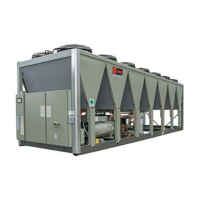CG-SVX039C-GB
75
Monthly Maintenance
1. Perform all weekly maintenance procedures.
2. Manually rotate the condenser fans to ensure
that there is proper clearance on the fan shroud
openings.
3. Check water pump (option): Manually rotate the
pump. Remove plastic plug located at the bottom
of the motor frame to drain any condensation
which can occur in the motor.
4. Check and clean air filter of the control panel
(option).
5. In case of Twin-pump, make sure there is no pump
motor fault.
Note: pump operation will be alternated at each
new request of water flow or when a pump fault is
detected.
WARNING! Position all electrical disconnects in the
“OPEN” position and lock them to prevent injury
of death due to electrical shock or moving parts.
When electrical panels are ventilated, you need to
change the fan filter.
6. Make any repairs necessary.
Annual Maintenance
1. Perform all weekly and monthly procedures.
2. Check the oil sump oil level and refrigerant charge
while the unit is OFF.
Note: Routine changing of the oil is not required. Make
an oil analysis to determine the condition of the oil.
1. Have Trane or another qualified laboratory perform
a compressor oil analysis to determine system
moisture content and acid level. This analysis is a
valuable diagnostic tool.
2. Contact a qualified service organization to leak-
test the chiller, to check operating and safety
controls, and to inspect electrical components for
deficiencies.
3. Inspect all piping components for leakage and
damage.
4. Clean all water strainers.
Notice: If the CGAF chiller / CXAF Heat pump
evaporator is drained of water, the freeze
protection heater must be de-energized. Failure to
de-energize the heater might cause it to burn out.
5. Clean and repaint any areas that show signs of
corrosion.
6. Clean the condenser coils.
7. Check and tighten all electrical connections as
necessary.
CAUTION! A clear sight glass alone does not mean that
the system is properly charged. Also check the rest of the
system operating conditions.
WARNING! Position all electrical disconnects in the
“Open” position and lock them to prevent injury or death
due to electrical shock.
8. Clean the condenser fans. Check the fan
assemblies for proper clearance in the fan shroud
openings and for motor shaft misalignment or
abnormal end-play, vibration and noise.
Refrigerant Emission Control
Conservation and emission reduction can be
accomplished by following recommended Trane
operation, maintenance, and service procedures,
with specific attention to the following:
1. Refrigerant used in any type of air-conditioning or
refrigerating equipment should be recovered and/or
recycled for reuse, reprocessed (reclaimed). Never
release refrigerant into the atmosphere.
2. Always determine possible recycle or reclaim
requirements of the recovered refrigerant before
beginning recovery by any method.
3. Use approved containment vessels and safety
standards. Comply with all applicable transportation
standards when shipping refrigerant containers.
4. To minimize emissions while recovering refrigerant,
use recycling equipment. Always attempt to use
methods that will pull the lowest possible vacuum
while recovering and condensing refrigerant into
containment.
5. Refrigerant-system cleanup methods that use filters
and dryers are preferred. Do not use solvents that
have ozone depletion factors. Properly dispose of
used materials.
6. Take extra care to properly maintain all service
equipment that directly supports refrigeration
service work, such as gauges, hoses, vacuum
pumps, and recycling equipment.
7. Stay aware of unit enhancements, conversion
refrigerants, compatible parts, and manufacturer’s
recommendations that will reduce refrigerant
emissions and increase equipment operating
efficiencies. Follow the manufacturer’s specific
guidelines for conversion of existing system.
8. In order to assist in reducing power-generation
emissions, always attempt to improve equipment
performances with improved maintenance and
operations that will help conserve energy resources.
Periodic Maintenance

